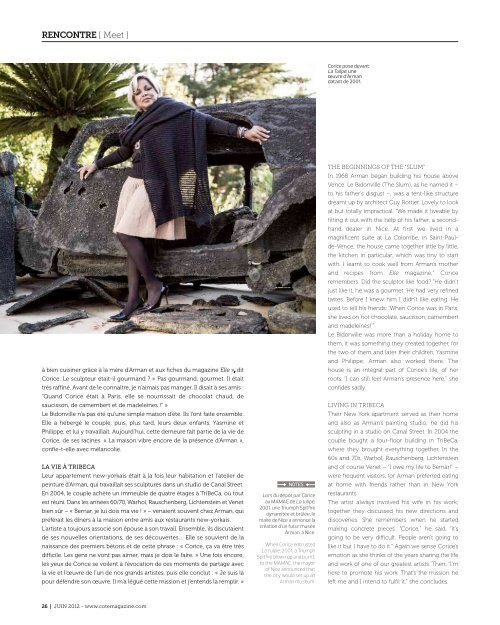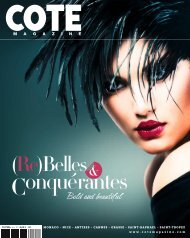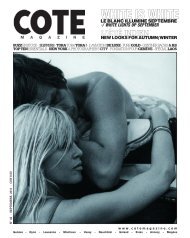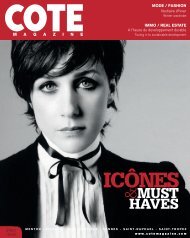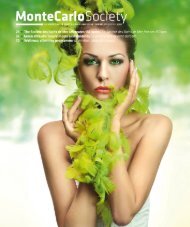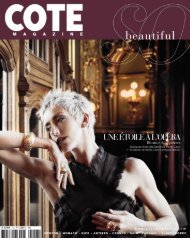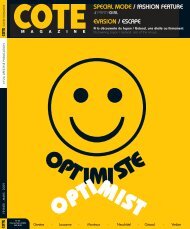Télécharger - Cote Magazine
Télécharger - Cote Magazine
Télécharger - Cote Magazine
Create successful ePaper yourself
Turn your PDF publications into a flip-book with our unique Google optimized e-Paper software.
RENCONTRE [ Meet ]<br />
à bien cuisiner grâce à la mère d’Arman et aux fiches du magazine Elle », dit<br />
Corice. Le sculpteur était-il gourmand ? « Pas gourmand, gourmet. Il était<br />
très raffiné. Avant de le connaître, je n’aimais pas manger. Il disait à ses amis :<br />
“Quand Corice était à Paris, elle se nourrissait de chocolat chaud, de<br />
saucisson, de camembert et de madeleines !” »<br />
Le Bidonville n’a pas été qu’une simple maison d’été. Ils l’ont faite ensemble.<br />
Elle a hébergé le couple, puis, plus tard, leurs deux enfants, Yasmine et<br />
Philippe, et lui y travaillait. Aujourd’hui, cette demeure fait partie de la vie de<br />
Corice, de ses racines. « La maison vibre encore de la présence d’Arman »,<br />
confie-t-elle avec mélancolie.<br />
LA VIE À TRIBECA<br />
Leur appartement new-yorkais était à la fois leur habitation et l’atelier de<br />
peinture d’Arman, qui travaillait ses sculptures dans un studio de Canal Street.<br />
En 2004, le couple achète un immeuble de quatre étages à TriBeCa, où tout<br />
est réuni. Dans les années 60/70, Warhol, Rauschenberg, Lichtenstein et Venet<br />
bien sûr – « Bernar, je lui dois ma vie ! » – venaient souvent chez Arman, qui<br />
préférait les dîners à la maison entre amis aux restaurants new-yorkais.<br />
L’artiste a toujours associé son épouse à son travail. Ensemble, ils discutaient<br />
de ses nouvelles orientations, de ses découvertes… Elle se souvient de la<br />
naissance des premiers bétons et de cette phrase : « Corice, ça va être très<br />
difficile. Les gens ne vont pas aimer, mais je dois le faire. » Une fois encore,<br />
les yeux de Corice se voilent à l’évocation de ces moments de partage avec<br />
la vie et l’œuvre de l’un de nos grands artistes, puis elle conclut : « Je suis là<br />
pour défendre son œuvre. Il m’a légué cette mission et j’entends la remplir. »<br />
26 | JUIN 2012 - www.cotemagazine.com<br />
NOTES<br />
Lors du dépôt par Corice<br />
au MAMAC de La tulipe,<br />
2001, une Triumph Spitfire<br />
dynamitée et brûlée, le<br />
maire de Nice a annoncé la<br />
création d’un futur musée<br />
Arman, à Nice.<br />
When Corice entrusted<br />
La tulipe, 2001, a Triumph<br />
Spitfire blown up and burnt,<br />
to the MAMAC, the mayor<br />
of Nice announced that<br />
the city would set up an<br />
Arman museum.<br />
Corice pose devant<br />
La Tulipe, une<br />
œuvre d’Arman<br />
datant de 2001.<br />
THE BEGINNINGS OF THE “SLUM”<br />
In 1968 Arman began building his house above<br />
Vence. Le Bidonville (The Slum), as he named it –<br />
to his father’s disgust –, was a tent-like structure<br />
dreamt up by architect Guy Rottier. Lovely to look<br />
at but totally impractical. “We made it liveable by<br />
fitting it out with the help of his father, a secondhand<br />
dealer in Nice. At first we lived in a<br />
magnificent suite at La Colombe, in Saint-Paulde-Vence;<br />
the house came together little by little,<br />
the kitchen in particular, which was tiny to start<br />
with. I learnt to cook well from Arman’s mother<br />
and recipes from Elle magazine,” Corice<br />
remembers. Did the sculptor like food? “He didn’t<br />
just like it, he was a gourmet. He had very refined<br />
tastes. Before I knew him I didn’t like eating. He<br />
used to tell his friends: ’When Corice was in Paris,<br />
she lived on hot chocolate, saucisson, camembert<br />
and madeleines!’”<br />
Le Bidonville was more than a holiday home to<br />
them, it was something they created together, for<br />
the two of them and later their children, Yasmine<br />
and Philippe; Arman also worked there. The<br />
house is an integral part of Corice’s life, of her<br />
roots. “I can still feel Arman’s presence here,” she<br />
confides sadly.<br />
LIVING IN TRIBECA<br />
Their New York apartment served as their home<br />
and also as Arman’s painting studio; he did his<br />
sculpting in a studio on Canal Street. In 2004 the<br />
couple bought a four-floor building in TriBeCa,<br />
where they brought everything together. In the<br />
60s and 70s, Warhol, Rauschenberg, Lichtenstein<br />
and of course Venet – “I owe my life to Bernar!” –<br />
were frequent visitors, for Arman preferred eating<br />
at home with friends rather than in New York<br />
restaurants.<br />
The artist always involved his wife in his work;<br />
together they discussed his new directions and<br />
discoveries. She remembers when he started<br />
making concrete pieces: “Corice,” he said, “it’s<br />
going to be very difficult. People aren’t going to<br />
like it but I have to do it.” Again we sense Corice’s<br />
emotion as she thinks of the years sharing the life<br />
and work of one of our greatest artists. Then: “I’m<br />
here to promote his work. That’s the mission he<br />
left me and I intend to fulfil it,” she concludes.<br />
www.piaget.fr<br />
Piaget Rose<br />
Boutique PIAGET - 3 avenue des Beaux-Arts - MONACO Service Client 01 58 18 14 15<br />
Or blanc, bague sertie diamant


